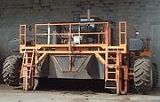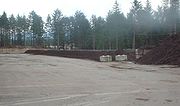
Windrow composting
Encyclopedia


Agriculture
Agriculture is the cultivation of animals, plants, fungi and other life forms for food, fiber, and other products used to sustain life. Agriculture was the key implement in the rise of sedentary human civilization, whereby farming of domesticated species created food surpluses that nurtured the...
, windrow composting is the production of compost
Compost
Compost is organic matter that has been decomposed and recycled as a fertilizer and soil amendment. Compost is a key ingredient in organic farming. At its most essential, the process of composting requires simply piling up waste outdoors and waiting for the materials to break down from anywhere...
by piling organic matter
Organic matter
Organic matter is matter that has come from a once-living organism; is capable of decay, or the product of decay; or is composed of organic compounds...
or biodegradable waste
Biodegradable waste
Biodegradable waste is a type of waste, typically originating from plant or animal sources, which may be degraded by other living organisms. Waste that cannot be broken down by other living organisms are called non-biodegradable....
, such as animal manure and crop residues, in long rows (windrow
Windrow
A windrow is a row of cut hay or small grain crop. It is allowed to dry before being baled, combined, or rolled. For hay, the windrow is often formed by a hay rake, which rakes hay that has been cut by a mower machine or by scythe into a row, or it may naturally form as the hay is mowed...
s). This method is suited to producing large volumes of compost. These rows are generally turned to improve porosity and oxygen content, mix in or remove moisture, and redistribute cooler and hotter portions of the pile. Windrow composting is a commonly used farm scale composting method. Composting process control parameters include the initial ratios of carbon
Carbon
Carbon is the chemical element with symbol C and atomic number 6. As a member of group 14 on the periodic table, it is nonmetallic and tetravalent—making four electrons available to form covalent chemical bonds...
and nitrogen
Nitrogen
Nitrogen is a chemical element that has the symbol N, atomic number of 7 and atomic mass 14.00674 u. Elemental nitrogen is a colorless, odorless, tasteless, and mostly inert diatomic gas at standard conditions, constituting 78.08% by volume of Earth's atmosphere...
rich materials, the amount of bulking agent added to assure air porosity, the pile size, moisture content, and turning frequency.
The temperatures of the windrows must be measured and logged constantly to determine the optimum time to turn the windrows for quicker compost production. Manually collecting data cannot be done continually and may expose the person collecting the data to harmful pathogens. Automatically collecting the data and transmitting the data wirelessly
Wireless sensor network
A wireless sensor network consists of spatially distributed autonomous sensors to monitor physical or environmental conditions, such as temperature, sound, vibration, pressure, motion or pollutants and to cooperatively pass their data through the network to a main location. The more modern...
back to a centralized location allows composting temperatures to be continually recorded and logged, improving efficiency and reducing the time needed to complete a composting cycle.
Compost windrow turners
Compost windrow turners were developed to produce compostCompost
Compost is organic matter that has been decomposed and recycled as a fertilizer and soil amendment. Compost is a key ingredient in organic farming. At its most essential, the process of composting requires simply piling up waste outdoors and waiting for the materials to break down from anywhere...
on a large scale by Fletcher Sims Jr. of Canyon, Texas. They are a traditionally a large machine that straddles a windrow of 4 feet (1.25 meters) or more high, by as much as 12 feet (3.5 meters) across. Although small machines exist for small windrows, most operations use larger machines for volume production. Turners drive through the windrow at a slow rate of forward movement. They have a steel drum with paddles that are rapidly turning. As the turner moves through the windrow, fresh air (oxygen
Oxygen
Oxygen is the element with atomic number 8 and represented by the symbol O. Its name derives from the Greek roots ὀξύς and -γενής , because at the time of naming, it was mistakenly thought that all acids required oxygen in their composition...
) is injected into the compost by the drum/paddle assembly, and waste gases produced by bacterial decomposition
Decomposition
Decomposition is the process by which organic material is broken down into simpler forms of matter. The process is essential for recycling the finite matter that occupies physical space in the biome. Bodies of living organisms begin to decompose shortly after death...
are vented. The oxygen feeds the aerobic bacteria and thus speeds the composting process.
Recent compost emissions sampling by Environmental Management Consulting raises questions about the presence of
methane in the emissions from windrow composting. One sample found that as much as 26 percent of the waste carbon may be emitted as methane and not carbon dioxide.
Utilization
To properly use a compost windrow turner, it is ideal to compost on a hard surfaced pad. Heavy-duty compost windrow turners allow the user to obtain optimum results with the aerobic hot composting process. By using four wheel drive
Four Wheel Drive
The Four Wheel Drive Auto Company, more often known as Four Wheel Drive or just FWD, was founded in 1909 in Clintonville, Wisconsin, as the Badger Four-Wheel Drive Auto Company by Otto Zachow and William Besserdich.-History:...
or tracks
Caterpillar track
Continuous tracks or caterpillar tracks are a system of vehicle propulsion in which modular metal plates linked into a continuous band are driven by two or more wheels...
the windrow turner is capable of turning compost in windrows located in remote locations. With a self-trailering
Self-trailering
Self-trailering is an engineering design that enables a large piece of equipment to convert or transform into a trailer.Much agricultural equipment is manufactured in this way. It is then designed to be driven through the field in one direction, and trailered in the other direction. Examples...
option this allows the compost windrow turner to convert itself into a trailer to be pulled by a semi-truck tractor
Tractor
A tractor is a vehicle specifically designed to deliver a high tractive effort at slow speeds, for the purposes of hauling a trailer or machinery used in agriculture or construction...
. These two options combined allow the compost windrow turner to be easily hauled anywhere and to work compost windrows in muddy and wet locations.
Specific applications
Molasses based Distilleries all over the world generate large amount of effluent termed as spent wash or vinasse. For each liter of alcohol produced, around 8 liters of effluent is generated. This effluent has COD of 1,50,000 PPM and BOD of 60,000 PPM and even more. This effluent needs to be treated and the only effective method for conclusive disposal is by Composting.Sugar Factories generate pressmud / cachaza during the process and the same has about 30% fibers as Carbon and has large amounts of water. This pressmud is dumped on prepared land in the form of 100 meters long windrows of 3 meters x 1.5 meters and spent wash is sprayed on the windrow while the windrow is being turned. Composting machines called Windrow King, Windrow Prince and Windrow Queen are used for this applications. These machines help consume spent wash of about 2.5 times of the volume of the pressmud, which means that a 100 meters of windrow accommodates about 166 MT of pressmud and uses about 415 m³ of Spent wash in 50 days.
Microbial Culture TRIO COM-CULT is used about 1 kg per MT of pressmud for fast de-composing of the spent wash. Lakhs (Indian term for 100,000) of m3 of spent wash is being composted all over the world in countries like India, Colombia, Brazil, Thailand, Indonesia, South Africa etc.
Composting machines Windrow King/Prince/Queen of various capacities of 336 HP, 153 HP and 80 Hp are being used all over the world for this application round the clock. The technology of composting spent wash / Vinasse is called TAS BIO-COM. The compost yard has to be prepared as per the norms of local countries however it has to be prepared in such a way that the land is impervious and does not allow the liquid effluent to pass down into the earth. The compost yard has to be located at a place where the smell of composting operations is not allowed to spread, as any composting operation generates foul smell. The compost thus generated, is of excellent quality and is rich in nutrients and it takes care of balance of nature. The products derived from nature go back to nature.
External links
- Windrow Dynamics
- Windrow Composting - Grass Straw (retrieved March 17, 2009)
- Manufacturer of indurstial composting equipment

